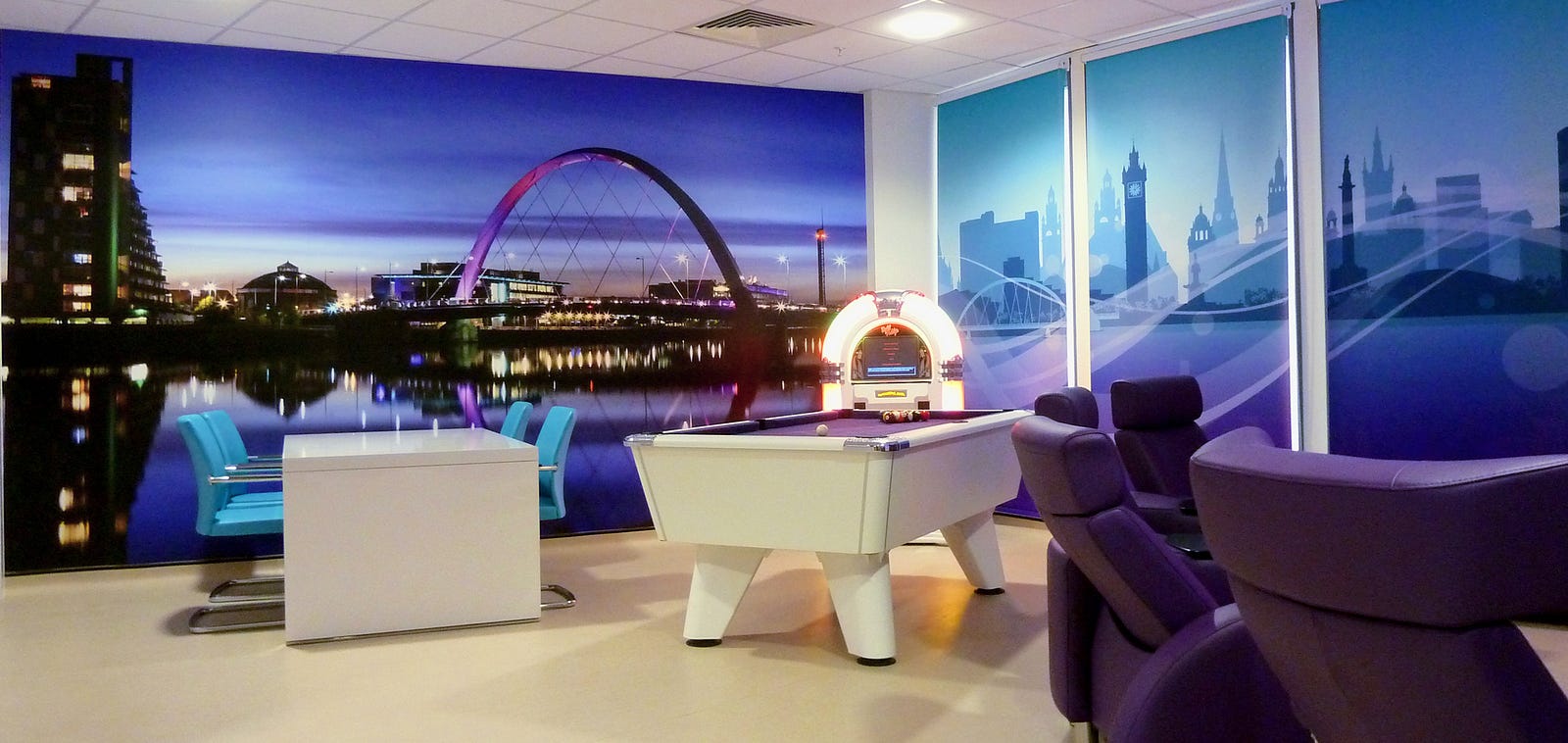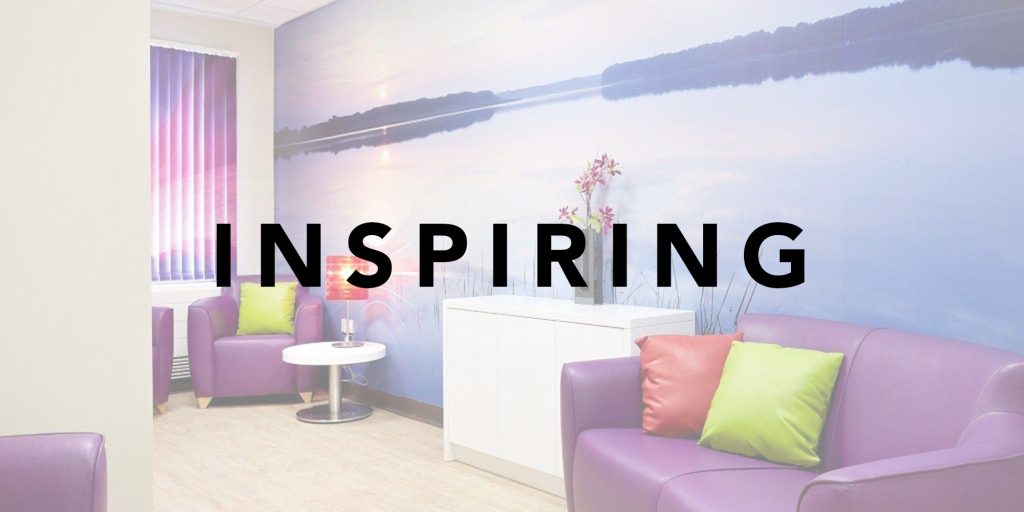Yet the one thing that is missing is? Soul.
So many times I have been almost embarrassed by the response to our wall art. The reason why is teams of people have spent tens of thousands of collective hours slogging their hearts out to build these perfect buildings, only for us to come in for a couple of days and completely change the atmosphere from a sterile white box into a place people love to be in.
We have been in spaces where staff have been almost overwhelmed by the transformation, so thankful to us for our little part. This is why I feel embarrassed, we roll in at the last moment just when the team are about to move in and we get all the praise. The chippy, the sparky and the plasterer’s contribution is a distant memory.
We can’t claim full responsibility for the ‘soul’ that arrives as we leave, as we work with some brilliant interior designers and architects who understand their client’s needs. Our part is that we are merely the facilitators, the artworkers, the printers and the installers. We are the people who convert the digital world of the screen, into the real world of beautiful spaces.
Over the years, we have been working in the commercial interior design sector. We have worked on projects for multi-million pound contractors and we have worked with facilities teams of private companies who have no formal design processes. We have seen spaces at all stages, on plans, before the space is started, to the main shell of the building, and when the trades are in doing their first fix. We turn up in the middle of this hustle and bustle to do a site survey, and a few weeks later we arrive with rolls of print ready to do the makeover. We install all the artwork from company logos, picturesque wooded forest murals, beautiful tropical scenery, text, images or colourful fun stickers. That dirty and noisy space from a few weeks ago is now a beautiful and noisy space as the new occupants go about their business, doing what they do best (and often better, as their work ethic is heightened by their new space).
It is true that great spaces make business, learning or healthcare better. I was recently speaking to someone who works at a global accountancy firm and they commented on the way the team worked better in their new space and how work seemed easier. Many businesses and institutions work in stale white walled boxes with little thought about how those walls could impact the productivity of workers, or the welfare of patients, or the aptitude of students young and old.
Workers tend to have increased performance and motivation in spaces they enjoy being in. There are, of course, many aspects to creating a productive space, but walls are often one of the largest untapped opportunities.
Motivational slogans may be a thing of a previous management era, but beautiful photography and subtle designs can give a sense of pleasure and belonging. The effect is that people can work with a clearer mindset for longer periods of the day. Staff tend to ‘buy-in’ to businesses that make the environment more pleasant for them.
Pupils and students learning in a school or college respond to their environment in positive and negative ways. If buildings are old and dilapidated, students may subconsciously assume education is not worth the effort, or there is no point investing in their education as the school has not invested in the buildings that surround the education system.
Environment has long been known to have an effect on student attendance and performance. A creative environment does not just benefit artistic students; creative solutions to design in buildings or spaces can foster a spirit of innovation and problem solving for use in many subjects like maths, science and technology. The lines often blur between these sectors. Encouraging creativity in learning, technology, sciences and art may impact British commerce for decades to come.

One of our clients works exclusively in healthcare and in aiding them to make hospitals better places, we see that white or magnolia rules the corridors of most of Britain’s healthcare system.
While this may not offend anyone and may look clean, in many cases there is a distinct lack of thought given to the way patients, visitors and staff respond to those spaces. The NHS is a ‘system’ to care for and make people better in the most efficient way possible; the building is often only seen as something to house this ‘system’.
However, studies done by charities like Teenage Cancer Trust show that the right environment can have a significant effect on young patients’ mental outlook. Studies have also shown improved outlook has an impact on healing and improved patient outcome, which means the design of the building becomes a more significant part of the ‘system’. Not only does that have a positive effect on patients, but it is also better for healthcare staff morale. With much talk about the future of the NHS in recent times, it is easy to see there would be a long-term reduction in costs if patients went home from hospital sooner, and improved staff morale could create more effective teams.
We also work in business and institutions. In medium to large businesses throughout the UK there is much hype about innovation and creativity. In fact, even the government would encourage us to get creative and fly the flag around the world for Britain.
We can’t make your company grow, but we can offer this little idea. That dusty boardroom on the 4th floor, that no one uses anymore that has the collection of all the ‘dead’ furniture? That could become a social hub or breakout zone; an area encouraging staff to meet, work and talk. It could be a space for ideas to cross-pollinate from department to department. It would no longer be a ‘dumping ground’, it would become an essential space for innovation, the engine room of the company.
Imagine your top salesperson sits down to create a presentation for your latest widget in your new innovation space, and he ends up sharing a coffee with the engineer who built the widget. The salesperson wonders why the widget does not have a particular feature that all the customers seem to want. That one conversation might change your company’s fortunes overnight, just because two people who don’t normally meet are in the same room.
This may be a hypothetical situation, but the concept has been adopted by some of the world’s most innovative companies like Google and Apple who use this concept of idea cross-pollination by having shared kitchens between different disciplines, or by moving staff around their offices regularly to encourage diverse thinking. It will need a little more than just a nice mural to turn a space into an innovation hotspot, but with a great interior designer on board and a supportive company policy, who knows if that space could foster the release of the ‘next big thing’.

Your space does not need to be solely about function. Gone are the days when people would choose to work for you just for pay – employees look for a full package and that includes the work space. The vibe or spirit of the place needs to shout ‘you’ll be great in this space!’ It needs to facilitate, to innovate, to make us feel cared for, to encourage us, to push us and fill us with optimism. Nature can do all these things for us.
You have probably been on a moorland or a rocky beach and had similar feelings. So why not bring nature into work spaces with huge images of open landscapes, beautiful trails through woodland, the beauty in the details of a flower, or a sunset overlooking paradise. Photographic murals are only our way of doing this, but get a great designer on board and they will bring in many more elements to make spaces inspiring. If we look at our species, two things are linked all the way through our journey from our ancient ancestors up until now: one is nature and the second is other people. A great space will give you beautiful inspiration and facilitate interaction with other inspiring people. These are the seeds of human progress.
